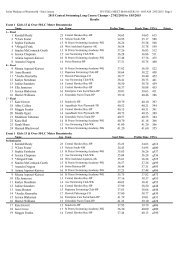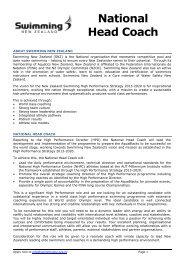LTAD Borders Swimming Community - Final
LTAD Borders Swimming Community - Final
LTAD Borders Swimming Community - Final
You also want an ePaper? Increase the reach of your titles
YUMPU automatically turns print PDFs into web optimized ePapers that Google loves.
LEVELS THREE A, B & FOURAt the beginning of Level 3A swimmers should becompleting 24,000m - 32,000m/week. Therefore if aLevel 3A swimmer is attending the recommended 6sessions per week they should be completing a minimumof 4000m per session. Swimmers will need sessions ofup to 2 hours to complete these volumes. This should beoccurring over approximately 48 weeks of the year.By the end of Level 3B the swimmers should be aimingat 44,000km – 52,000m/week. Therefore if a Level 3Bswimmer is attending the recommended 8 sessionsper week they should be completing a minimum of5,500m per session. Swimmers will need sessions of upto 2 hours to complete these volumes. This should beoccurring over 48 weeks of the year.Level 4 swimmers should be doing similar or slightly highervolumes to Level 3B swimmers each session, but should beaiming to train over ten sessions per week. Swimmers willneed sessions of up to 2 hours to complete these volumes.This should be occurring over 48 weeks of the year.WHY DO SWIMMERS NEED TO TRAIN SO MUCH?It’s common knowledge that participants of manyteam sports can often perform at the national level onjust two or three training sessions per week. This iscertainly not the case for swimmers – the norm for highschool-aged swimmers in Australia and the U.S.A. is10 two hour pool sessions per week plus additionalland training activities. So why do swimmers train somuch?Adaptation to the Medium of Water and <strong>Swimming</strong>Activity – The more often a human swims the morequickly and effectively their body and senses adapt towater, and the activity of swimming. An example of anadaptation to water is the increased “feel” swimmersoften develop for reducing drag and for manipulatingthe water for maximum propulsion. An example of anadaptation to swimming specific activity is an increasein general size and strength of the upper body while thelegs of swimmers remain generally quite underdevelopedin comparison. As land-based animals, water is notthe natural environment of humans. Therefore, tofacilitate greater adaptation to the water for increasedperformance, young humans should swim often whilegrowing and developing. This is why it is so important foryoung swimmers to be in the water frequently, rather thanless often but for longer periods. For example, four 1.5hour training sessions per week are more beneficial thantwo 3 hour sessions per week.Development of Feel, Depth Perception & SpatialAwareness – Swimmers who train more often tendto develop a greater “feel for the water”, an increasedperception of the depth of their body after starts andturns, and improved spatial awareness in the water...which, for example, is useful for a swimmer in knowinghow far from the wall they should prepare for a turn orfinish. These intuitive qualities, which collectively couldbe referred to as the “art of swimming”, are developedto a greater degree the more frequently swimmers train,particularly while still growing and developing.Establishing Automatic Movement Patterns ThroughRepetition – As for all sports, repetition ofmovement establishes habitual movementpatterns. Once the neuromuscularsystem has been exposedto sufficient repetition of aparticular movement pattern,desirable techniques andskills can be performedmore easily andautomatically.Creating a Foundation– Within both an entireswimming career anda single preparation/season, swimmers mustestablish an aerobic andtechnical foundation, throughcompleting significant trainingvolumes, on which to developall components of fitness morecomprehensively.Recovery – Active recovery from significant workloads isgenerally accepted as being more effective than passiverecovery (i.e. remaining idle). The need for active recoverysubsequently leads to a requirement for additionaltraining sessions.Windows of Opportunity – There are critical periods,during a human’s development, of optimal trainability forvarious components of fitness. These critical periods areoften referred to as windows of opportunity. It is generallyaccepted by sports scientists and coaches that if thedevelopment of a component of fitness is neglectedduring its window of opportunity, the athlete will neverdevelop that component to its optimum, no matter howmuch time and effort is spent on trying to develop it later.It is essential that enough time is spent training relevantcomponents of fitness during critical periods.




